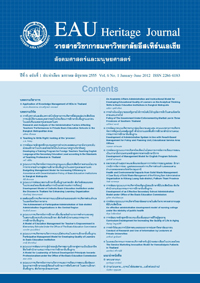โมเดลนวัตกรรมการตลาดบริการสำหรับผู้ป่วยฟอกเลือดในประเทศไทย
Keywords:
การบริหารจัดการลูกค้าสัมพันธ์, service marketing innovation model, hemodialysis (HD) patientsAbstract
งานการวิจัยนี้มีจุดประสงค์เพื่อสร้างโมเดลนวัตกรรมการตลาดบริการสำหรับผู้ป่วยฟอกเลือดในประเทศไทย โดยใช้การวิจัยแบบผสมผสานระหว่างการวิจัยเชิงคุณภาพและการวิจัยเชิงปริมาณ ประชากรที่ศึกษาเป็นผู้ป่วยฟอกเลือด ในกรุงเทพและปริมณฑลจำนวน 8,122 คน สุ่มตัวอย่างแบบแบ่งชั้นหลายขั้นตอนได้ประชากร 544 คน เริ่มการวิจัย โดยการสัมภาษณ์เชิงลึกผู้มีประสบการณ์ด้านไตเทียม 6 ท่าน ได้แก่ อายุรแพทย์โรคไต พยาบาลไตเทียม ผู้ให้บริการ และผู้ป่วยไตเทียม หลังจากนั้น ใช้แบบสอบถามรวบรวมข้อมูล แบบสอบถามมีค่าความเชื่อมั่นเท่ากับ 0.80 ใช้สถิติ เชิงพรรณนาวิเคราะห์ตัวแปร สถิติทดสอบสมมติฐาน ได้แก่ สถิติทดสอบที และทดสอบความสัมพันธ์เชิงสาเหตุ วิเคราะห์ โมเดลด้วยโมเดลสมการโครงสร้าง (SEM) หลังจากนั้นได้ทำการประเมินผลอีกครั้ง เพื่อยืนยันผลสัมฤทธิ์ของโมเดล ผลการวิจัย พบว่า โมเดลนวัตกรรมการตลาดบริการสำหรับผู้ป่วยฟอกเลือดประกอบด้วยปัจจัยด้านการตลาด และปัจจัย ด้านจิตวิทยา (8P’s and CRM) ปัจจัยการตลาดที่สำคัญที่สุดได้แก่กลยุทธ์การบริหารลูกค้าสัมพันธ์ และปัจจัยจิตวิทยา มีอิทธิพลอย่างมากต่อผลสัมฤทธิ์ โมเดลนวัตกรรมการบริการสำหรับผู้ป่วยฟอกเลือดในประเทศไทยที่นำเสนอ ประสบผลสำเร็จ โดยวัดจากดัชนีชี้วัด ความสุขโดยรวม การบอกต่อ และพฤติกรรมส่งเสริมสุขภาพ ดัชนีความสอดคล้องของโมเดล ได้แก่ ค่า Chi-square/df, GFI, AGFI, CFI, RMR, RMSEA และ Hoelter index อยู่ในเกณฑ์มาตรฐานโมเดล ประกอบด้วย ปัจจัยส่วนประสมทางการตลาด(8P’s) และการบริหารจัดการลูกค้าสัมพันธ์ (CRM) ปัจจัยด้านจิตวิทยา ได้แก่ ทัศนคติ การรับรู้ และแรงจูงใจ
The Service Marketing Innovation Model for Hemodialysis Patients in Thailand
This research presents the service marketing innovation model for hemodialysis patients in Thailand by using qualitative and quantitative research methods. The population is the hemodialysis patients in Bangkok and its vicinity. The total population is 8,122. This research uses a sample of 544 patients. The sampling design uses multistage sampling. The qualitative research consists of in-depth interviews of six experts in the hemodialysis field who are nephrologist, hemodialysis nurses, hemodialysis providers and hemodialysis patients. This research uses a questionnaire for collecting the quantitative data. Descriptive statistics were used to analyze variables. Statistical methods used to test hypotheses were Paired t-test and Structural Equation Modeling (SEM). Confirmatory Factor Analysis was used to confirm the component of latent variables. SEM was used to analyze the model. Research found that the innovation model consists of 2 factors, namely service marketing factors (8P’s and CRM) and psychological factors. Two latent variables-marketing factors and psychological factors were found to have a significant positive impact on the performance of service. Moreover, the performance of the service marketing innovation model increased after the implementation of new services. All fit indices for the model, which were Chi-square/df, GFI, AGFI, CFI, RMR, RMSEA and Hoelter index, met the standard values. The marketing and psychological factors explained 72.2 percent of the performance of that service marketing model.





